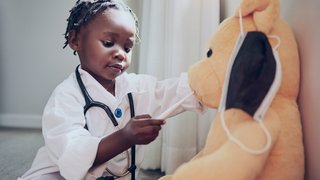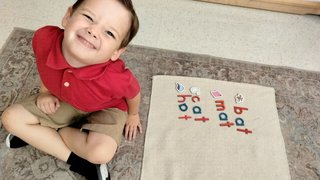Parents’ guide to hand, foot, and mouth disease
October 21, 2024

In June, headlines in San Antonio alerted parents that an illness called hand, foot, and mouth disease (HFMD) was on the rise around the area. With school having starting up recently, it won’t be a surprise if similar reports pop up in North Texas.
It’s never fun to hear pediatricians warning of an outbreak or to get that dreaded note from your school or day care alerting you to a confirmed case. Fortunately, with HFMD, the alarm is more of a call to “be on the lookout” rather than a “red alert.”
It’s also a reminder to take preventive measures against HFMD, which is highly contagious. Though it’s a common illness and most do fairly well from this virus, it can be miserable for your child and family as it spreads through the home – including to adults. In fact, your sick child may need to be isolated at home for as long as seven to 10 days.
Children with HFMD will develop sores around their mouth and a tell-tale rash on the palms of their hands and soles of their feet. Parents may also notice flulike symptoms such as:
- Low-grade fever
- Lack of appetite
- Fatigue
HFMD is usually caused by coxsackievirus A16 and enterovirus-A71. Because it is caused by a virus and not bacteria, it can’t be cured with antibiotics. Most cases occur in children younger than 5, although we do see cases in elementary schools. Adults can catch HFMD from their children, and those who are immunocompromised are at higher risk.
There is no vaccine for HFMD and no specific treatment, but the good news is that most cases clear up with a little time and supportive care. As the school year kicks off, now is a good time to understand what causes HFMD, how it spreads, and how to prevent it.
“Generally, patients with hand, foot, and mouth disease can be managed at home. Occasionally, kids, especially younger ones who can’t stay hydrated at home, may need either an emergency room visit or a short admission. If they are admitted, the focus ensures that the patient can stay hydrated and pain is adequately controlled. The stay is usually fairly short and the kids do really well once they return home.”
Dr. Clifford Chen, UTSW Medical Center pediatrician
How is HFMD diagnosed and treated?
Like the common cold and other viruses, HFMD will need to just run its course. Children may feel wretched for the first few days – the fever can zap their energy, and the rash might get itchy or uncomfortable. The hallmark of the presentation is small bumps on the arms and legs and ulcers of the mouth, giving it the name of hand-foot-mouth disease. When painful mouth sores appear on the lips or inside the mouth or throat, children may resist eating or drinking.
If you think your child might have HFMD, seek medical attention from your family’s pediatrician. The provider might ask you to bring your child in or might be able to make a diagnosis through a telehealth visit. If you go to urgent care, let staff know ahead of time that your child may have HFMD.
It takes a while for this virus to run its course, and most kids with HFMD won’t need ongoing care from a doctor. We advise parents to keep their children home until all the symptoms are gone to avoid spreading the illness. At-home treatments focus on keeping the child comfortable:
- Over-the-counter pain relievers or fever reducers such as acetaminophen or ibuprofen
- Cold fluids (avoid juice, soda, or sports drinks, which are acidic and may worsen mouth pain)
- Nutritious foods
- Rest
In rare cases when a child is unable to stay hydrated with oral intake, an emergency visit for hydration or a short hospitalization may be warranted to ensure the child remains hydrated during the illness.
Within seven to 10 days, most children bounce back to their normal routines without a visit to the doctor. Adults with HFMD may find their symptoms more disruptive to day-to-day activities.
When should you call the doctor?
Contact a health care provider for HFMD if:
- Your baby is younger than 6 months old.
- Your child is immunocompromised.
- Pain can’t be managed with over-the-counter medication.
- The fever spikes above 102 degrees.
- You’re concerned about dehydration.
- Symptoms aren’t improving after 10 days.
Is HFMD the same virus that animals get?
HFMD is not the same as hoof-and-mouth disease, a viral infection in animals with divided hooves, such as cows, pigs, sheep, goats, and deer. The animal virus cannot be transmitted to humans.

How does HFMD spread?
Like whooping cough, RSV, and COVID-19, HFMD is transmitted by touching or ingesting droplets of saliva. It can also spread by contact with fecal matter. This can happen from:
- Sneezing and coughing
- Close contact
- Sharing eating or writing utensils
- Touching doorknobs and other surfaces
- Changing diapers or using the restroom
- Putting fingers or toes in the mouth
- Swallowing contaminated water

How can you reduce the risk of HFMD?
The protocols for preventing the spread of HFMD are the same as many other infectious diseases:
- Wash hands frequently and thoroughly.
- Clean and disinfect shared surfaces such as doorknobs, tabletops, and chairs often.
- Avoid close contact with anyone who might be infected.
Preventing the spread of HFMD requires awareness and vigilance from every parent and teacher. If your child has HFMD, notify the school or day care and keep your child at home. The Centers for Disease Control and Prevention recommends children with HFMD can return to school or child care when they have no fever, are feeling well enough to participate in class, and have no uncontrolled drooling with mouth sores.
Your child care or school may have a different policy regarding when your child can return. Contact them or talk with your child’s health care provider. We can’t expect small children to restrict their activities among their friends, so it’s up to us to provide a safe, healthy environment.
To talk with a pediatrician about HFMD, call 214-645-8300 or request an appointment online.











